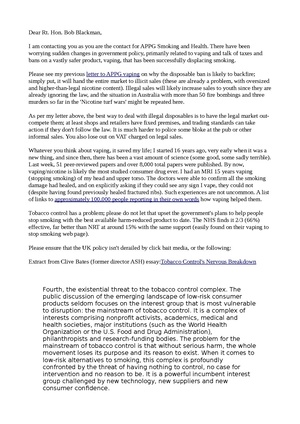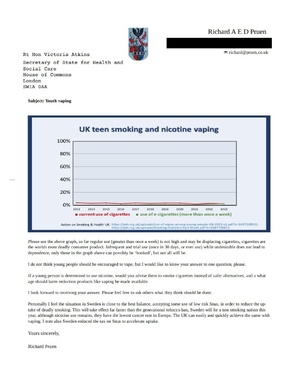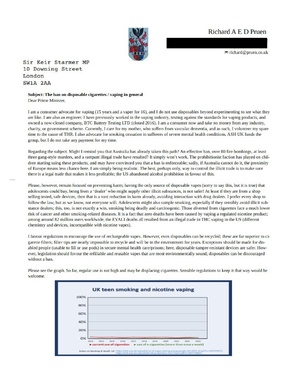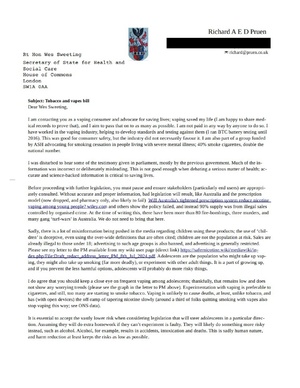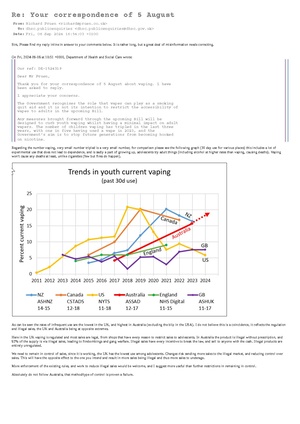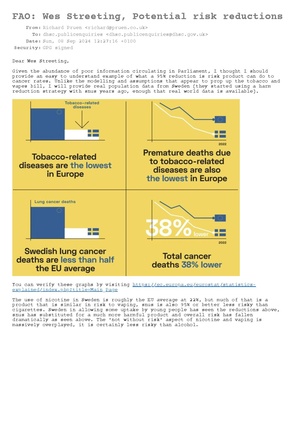UserWiki:Richardpruen: Difference between revisions
Richardpruen (talk | contribs) add reply from DHSC and my response |
Richardpruen (talk | contribs) add email to Wes Streeting 8th sept |
||
| Line 97: | Line 97: | ||
[[File:Email 6th sept DHSC reply.pdf|thumb|alt=Sirs, Please find my reply inline in answer to your comments below. It is rather long, but a great deal of misinformation needs correcting. On Fri, 2024-09-06 at 10:51 +0000, Department of Health and Social Care wrote: Our ref: DE-1524319 Dear Mr Pruen, Thank you for your correspondence of 5 August about vaping. I have been asked to reply. I appreciate your concerns. The Government recognises the role that vapes can play as a smoking quit aid and it is not its intention to restrict the accessibility of vapes to adults in the upcoming Bill. Any measures brought forward through the upcoming Bill will be designed to curb youth vaping whilst having a minimal impact on adult vapers. The number of children vaping has tripled in the last three years, with one in five having used a vape in 2023, and the Government’s aim is to stop future generations from becoming hooked on nicotine. Regarding the number vaping, very small number tripled is a very small number, for comparison please see the following graph (30 day use for various places) this includes a lot of experimental use that does not lead to dependence, and is sadly a part of growing up, adolescents try adult things (including alcohol at higher rates than vaping, causing deaths). Vaping won't cause any deaths at least, unlike cigarettes (few but fires do happen). As can be seen the rates of infrequent use are the lowest in the UK, and highest in Australia (excluding the blip in the USA). I do not believe this is a coincidence, it reflects the regulation and illegal sales, the UK and Australia being at opposite extremes. Here in the UK vaping is regulated and most sales are legal, from shops that have every reason to restrict sales to adolescents. In Australia the product is illegal without prescription, and 92% of the supply is via illegal sales, leading to firebombings and gang warfare. Illegal sales have every incentive to break the law, and sell to anyone with the cash. Illegal products are entirely unregulated. We need to remain in control of sales, since it is working, the UK has the lowest use among adolescents. Changes risk sending more sales to the illegal market, and reducing control over sales. This will have the opposite effect to the one you intend and result in more sales being illegal and thus more sales to underage. More enforcement of the existing rules, and work to reduce illegal sales would be welcome, and I suggest more useful than further restrictions in remaining in control. Absolutely do not follow Australia, that method/type of control is proven a failure. In the data above from ASH, we can see that 0.8% young people are vaping regularly having not also been a smoker, vaping is vastly safer than smoking, diverting them from cigarettes is a highly positive outcome. Given the data, and we must rely on data and facts here, all but 0.8% are diverted from cigarettes, and that means virtually no smoking naive youth are going on to regularly vape. This quite near to the ideal situation, changes in legislation that might make this worse (by increasing illegal sales) should be avoided. If it is working, don't fix it? While it is certainly true that adults prefer fruit and sweet flavours, many flavours on the market are overly appealing to children.Evidence shows that children are attracted to the fruit and sweet flavours of vapes, both in their taste and smell, as well as how they are described. Many flavours have attractive wording and names that entice children to try vaping, such as ‘gummy bear’ and ‘rainbow burst’. Nonsense, gummy bears are a sweet from my childhood, they may exist still, but I would buy that, I contest that is targeted at memories of adults. You might have more information on this, you should speak to the actual consumers of the product before jumping to easy sounding conclusions. New Nicotine Alliance are a charity funded exclusively by consumers and represent them, they would be a great point of contact. A consumer only org eliminates possible issues with manufacturer or even tobacco company influence. The Government is aware that vape flavours are an important consideration for adult smokers when seeking to quit smoking and it will carefully consider any restrictions to avoid unintended consequences. The primary purpose of the Tobacco and Vapes Bill is to reduce smoking rates by bringing forward a generational ban on the sale of tobacco, making it an offence for anyone to sell tobacco products to anyone born on or after 1 January 2009. This policy is not being implemented for vapes because the health advice is clear that vaping is less harmful than smoking; however, vaping is not risk-free and nor is the consumption of nicotine. https://x.com/JonathanFoulds/status/1829195343780819169 The tobacco part of the bill is irrelevant according to this, and economists everywhere, cigarettes are going away. By the time the generational ban has any effect, there will have been no uptake of smoking for some years, and thankfully that will result in faster reductions in death and disease. The Generational ban is too slow, no effect for more than 20 years, but thankfully, THR (tobacco harm reduction) will have more effect and way faster, it has already begun as above. Nicotinecauses addiction rapidly and can increase the risk of developing conditions such as cardiovascular disease, gastrointestinal disorder and more rapid development of some cancers. Giving up nicotine is very difficult, and withdrawal symptoms can include cravings, irritability, anxiety, trouble concentrating, headaches and other mental symptoms. Evidence also suggests that the brain in adolescence is more sensitive to the effects of nicotine, so there could be additional risks for young people. That is why it is vital that vapes are only used as a smoking cessation tool. Vapes are an effective quit tool for smokers, particularly when combined with behavioural support. Therefore, it is important that vapes remain accessible to adult smokers. The Government remains fully committed to the Swap to Stop scheme, which involves swapping cigarettes for vapes. This part is shocking, and awful both at the same time. The misinformation presented to government is terrible. There is no good evidence that nicotine outside smoking increases the risk of cardiovascular disease, in fact long term studies in Sweden show nicotine from Snus is not associated with increase in cardiovascular risk, nor with any sort of cancer. Since Snus has been popular for a long time the evidence is based on studies of the actual population, much more reliable than e.g. extrapolation from cell or animal studies. Would you provide the source of this disinformation (Cardiovascular desease, gastrointestinal desease, cancer risk), and who presented it, please? This is important, the government needs true and up to date information, and sources of poor/disinformation need to be tackled. Further there is good evidence that nicotine can treat some gastrointestinal problems, please may I have the source for your claim it is a cause. I present some peer reviewed papers below, none are industry funded. I can present more if you would like? https://academic.oup.com/ntr/advance-article-abstract/doi/10.1093/ntr/ntae193/7727428 "Despite different mechanisms of action, both ENDS and CCs attenuated on-going colon inflammation, enhanced healing and ameliorated recovery of injured intestines of DSS-treated mice and UC patients." Citation: Kastratovic N, Markovic V, Arsenijevic A, Volarevic A, Zdravkovic N, Zdravkovic M, Brankovic M, Gmizic T, Harrell CR, Jakovljevic V, Djonov V, Volarevic V. The effects of combustible cigarettes and electronic nicotine delivery systems on immune cell-driven inflammation and mucosal healing in ulcerative colitis. Nicotine Tob Res. 2024 Aug 5:ntae193. doi: 10.1093/ntr/ntae193. Epub ahead of print. PMID: 39101540. https://www.frontiersin.org/articles/10.3389/fimmu.2022.826889/full Analysis of several studies - some animal. In general, nicotine is beneficial in ulcerative colitis; in particular, nicotine transdermal patches or nicotine enemas have shown significantly improved histological and global clinical scores of colitis, inhibited pro-inflammatory cytokines in macrophages, and induced protective autophagy to maintain intestinal barrier integrity. Citation: Zhang W, Lin H, Zou M, Yuan Q, Huang Z, Pan X and Zhang W (2022) Nicotine in Inflammatory Diseases: Anti-Inflammatory and Pro-Inflammatory Effects. Front. Immunol. 13:826889. doi: 10.3389/fimmu.2022.826889 Acknowledgements: This work was supported by the National Natural Science Foundation of China (grant number 81903319), Natural Science Foundation of Guangdong Province of China (grant number 2021A1515011220), Administration of Traditional Chinese Medicine of Guangdong Province of China (grant number 20211008), Special Fund for Young Core Scientists of Agriculture Science (grant number R2019YJ-QG001), Special Fund for Scientific Innovation Strategy—Construction of High-Level Academy of Agriculture Science (grant number R2018YJ-YB3002), Top Young Talents of Guangdong Hundreds of Millions of Projects of China (grant number 87316004), the foundation of director of Crops Research Institute, Guangdong Academy of Agricultural Sciences (grant number 202205) and Outstanding Young Scholar of Double Hundred Talents of Jinan University of China. https://www.hindawi.com/journals/grp/2008/237185/ Smoking has a detrimental effect in Crohn's disease (CD), but this may be due to factors in smoking other than nicotine. Given that transdermal nicotine benefits ulcerative colitis (UC), and there is a considerable overlap in the treatment of UC and CD, the possible beneficial effect of nicotine has been examined in patients with Crohn's colitis. In this relatively small study of patients with active Crohn's colitis, 6 mg nicotine enemas appeared to be of clinical benefit in most patients. They were well tolerated and safe. PDF Version Citation: J. R. Ingram, J. Rhodes, B. K. Evans, and G. A. O. Thomas, Hindawi Publishing Corporation, Gastroenterology Research and Practice, Volume 2008, Article ID 237185, 6 pages, doi:10.1155/2008/237185 Acknowledgements: J. R. Ingram was supported by the Gastrointestinal Foundation Trust. SLA Pharma gave financial support to the project. The authors are indebted to Dr. J. T. Green (of Cardiff and Vale Hospitals Trust) who referred patients, and to Professor G. T. Williams (GTW) who performed all histological assessments. Regarding nicotine addiction, the DSM requires significant harm as well as the difficulty in stopping use, the safer forms of nicotine do not pose sufficient risk/harm by that definition. Tobacco when smoked certainly does pose sufficient risk, thus addiction is justified. Loss of autonomy is not sufficient harm, though it does require consideration, if it where caffine in coffee would be addictive, not the more reasonable dependency forming. For the dependency of nicotine, your information appears out of date, I will deffer to Karl Fagerstrom, world leading expert and inventor of the most used dependency test for nicotine. Karl Fagerstrom | 14 December 2013 "We used to believe that nicotine is very dependence producing, but the evidence suggests that there are a number of problems with this statement. For example, animals do not self-administer nicotine as readily as they do other dependence producing drugs such as amphetamine, cocaine, and heroin (Villegier et al. 2003); nicotine is a relatively weak reinforcer in human laboratory studies (Perkins et al. 2001); abstinent smokers seem to prefer a much reduced or nicotine free e-cigarette rather than other - often stronger - nicotine-containing products like gum; and although nicotine replacement treatment is an effective aid for quitting smoking, its efficacy is moderate even in doses that replace most or all nicotine from the cigarettes formerly used (Dale et al. 1995). There is very little to no evidence for the abuse of nicotine when not delivered in a tobacco vehicle." https://nicotinepolicy.net/authors/karl-fagerstrom/dependence-on-tobacco-and-nicotine/ The above link contains more information expanding on the above, with references. The Vaping Products Duty did not form part of the previous Government’s Tobacco and Vapes Bill. Taxation is the responsibility of HM Treasury, which ran a public consultation on the proposals for the duty from 6 March to 29 May. HM Treasury and HM Revenue and Customs are currently considering responses to that consultation. There are no plans to introduce any tax changes as part of the upcoming Bill. I hope this reply is helpful. Thank you for the reply, it remains to be seen how useful this conversation is, it depends on your willingness to accept the evidence. Evidence is changing rapidly in tobacco and nicotine, this was not always the case, for a long time tobacco was the only source of nicotine in popular use, now that has changed (for the better with safer products, mostly not from the tobacco industry of old, I would argue). Regarding the tax, it need to be considered alongside policy, it as proposed is a 'sin tax' and will result in significant increase in illegal sales as tax avoidance adds to profitability, thus crime and sales to youth, as well as dissuading adults who smoke cigarettes from switching to a product that is likely to save their life. I would remind you that 30% of vape sales are illegal, I have previously written to explain some ways to reduce the impact of vapes on the environment (by a significant ten fold) and at the same time allow regulated products to out-compete the illegal products (making illegal sales nonprofitable is the easiest/cheapest control). A link o my previous letter https://safernicotine.wiki/mediawiki/index.php/File:Email_to_appg_vaping_28th_Feb_2023.pdf Yours sincerely, Correspondence Officer Ministerial Correspondence and Public Enquiries Department of Health and Social Care --------------------------------------------------------------------- ---------------------------------------------------- Please do not reply to this email. To contact the Department of Health and Social Care, please visit theContact DHSC section on GOV.UK To receive news about DHSC: sign up to our monthly newsletter This e-mail and any attachments is intended only for the attention of the addressee(s). Its unauthorised use, disclosure, storage or copying is not permitted. If you are not the intended recipient, please destroy all copies and inform the sender by return e-mail. Any views expressed in this message are not necessarily those of the Department of Health and Social Care. Please note: Incoming and outgoing email messages are routinely monitored for compliance with our policy on the use of electronic communications. -- Richard Pruen <richard@pruen.co.uk>|reply from DHSC and reply sent]] | [[File:Email 6th sept DHSC reply.pdf|thumb|alt=Sirs, Please find my reply inline in answer to your comments below. It is rather long, but a great deal of misinformation needs correcting. On Fri, 2024-09-06 at 10:51 +0000, Department of Health and Social Care wrote: Our ref: DE-1524319 Dear Mr Pruen, Thank you for your correspondence of 5 August about vaping. I have been asked to reply. I appreciate your concerns. The Government recognises the role that vapes can play as a smoking quit aid and it is not its intention to restrict the accessibility of vapes to adults in the upcoming Bill. Any measures brought forward through the upcoming Bill will be designed to curb youth vaping whilst having a minimal impact on adult vapers. The number of children vaping has tripled in the last three years, with one in five having used a vape in 2023, and the Government’s aim is to stop future generations from becoming hooked on nicotine. Regarding the number vaping, very small number tripled is a very small number, for comparison please see the following graph (30 day use for various places) this includes a lot of experimental use that does not lead to dependence, and is sadly a part of growing up, adolescents try adult things (including alcohol at higher rates than vaping, causing deaths). Vaping won't cause any deaths at least, unlike cigarettes (few but fires do happen). As can be seen the rates of infrequent use are the lowest in the UK, and highest in Australia (excluding the blip in the USA). I do not believe this is a coincidence, it reflects the regulation and illegal sales, the UK and Australia being at opposite extremes. Here in the UK vaping is regulated and most sales are legal, from shops that have every reason to restrict sales to adolescents. In Australia the product is illegal without prescription, and 92% of the supply is via illegal sales, leading to firebombings and gang warfare. Illegal sales have every incentive to break the law, and sell to anyone with the cash. Illegal products are entirely unregulated. We need to remain in control of sales, since it is working, the UK has the lowest use among adolescents. Changes risk sending more sales to the illegal market, and reducing control over sales. This will have the opposite effect to the one you intend and result in more sales being illegal and thus more sales to underage. More enforcement of the existing rules, and work to reduce illegal sales would be welcome, and I suggest more useful than further restrictions in remaining in control. Absolutely do not follow Australia, that method/type of control is proven a failure. In the data above from ASH, we can see that 0.8% young people are vaping regularly having not also been a smoker, vaping is vastly safer than smoking, diverting them from cigarettes is a highly positive outcome. Given the data, and we must rely on data and facts here, all but 0.8% are diverted from cigarettes, and that means virtually no smoking naive youth are going on to regularly vape. This quite near to the ideal situation, changes in legislation that might make this worse (by increasing illegal sales) should be avoided. If it is working, don't fix it? While it is certainly true that adults prefer fruit and sweet flavours, many flavours on the market are overly appealing to children.Evidence shows that children are attracted to the fruit and sweet flavours of vapes, both in their taste and smell, as well as how they are described. Many flavours have attractive wording and names that entice children to try vaping, such as ‘gummy bear’ and ‘rainbow burst’. Nonsense, gummy bears are a sweet from my childhood, they may exist still, but I would buy that, I contest that is targeted at memories of adults. You might have more information on this, you should speak to the actual consumers of the product before jumping to easy sounding conclusions. New Nicotine Alliance are a charity funded exclusively by consumers and represent them, they would be a great point of contact. A consumer only org eliminates possible issues with manufacturer or even tobacco company influence. The Government is aware that vape flavours are an important consideration for adult smokers when seeking to quit smoking and it will carefully consider any restrictions to avoid unintended consequences. The primary purpose of the Tobacco and Vapes Bill is to reduce smoking rates by bringing forward a generational ban on the sale of tobacco, making it an offence for anyone to sell tobacco products to anyone born on or after 1 January 2009. This policy is not being implemented for vapes because the health advice is clear that vaping is less harmful than smoking; however, vaping is not risk-free and nor is the consumption of nicotine. https://x.com/JonathanFoulds/status/1829195343780819169 The tobacco part of the bill is irrelevant according to this, and economists everywhere, cigarettes are going away. By the time the generational ban has any effect, there will have been no uptake of smoking for some years, and thankfully that will result in faster reductions in death and disease. The Generational ban is too slow, no effect for more than 20 years, but thankfully, THR (tobacco harm reduction) will have more effect and way faster, it has already begun as above. Nicotinecauses addiction rapidly and can increase the risk of developing conditions such as cardiovascular disease, gastrointestinal disorder and more rapid development of some cancers. Giving up nicotine is very difficult, and withdrawal symptoms can include cravings, irritability, anxiety, trouble concentrating, headaches and other mental symptoms. Evidence also suggests that the brain in adolescence is more sensitive to the effects of nicotine, so there could be additional risks for young people. That is why it is vital that vapes are only used as a smoking cessation tool. Vapes are an effective quit tool for smokers, particularly when combined with behavioural support. Therefore, it is important that vapes remain accessible to adult smokers. The Government remains fully committed to the Swap to Stop scheme, which involves swapping cigarettes for vapes. This part is shocking, and awful both at the same time. The misinformation presented to government is terrible. There is no good evidence that nicotine outside smoking increases the risk of cardiovascular disease, in fact long term studies in Sweden show nicotine from Snus is not associated with increase in cardiovascular risk, nor with any sort of cancer. Since Snus has been popular for a long time the evidence is based on studies of the actual population, much more reliable than e.g. extrapolation from cell or animal studies. Would you provide the source of this disinformation (Cardiovascular desease, gastrointestinal desease, cancer risk), and who presented it, please? This is important, the government needs true and up to date information, and sources of poor/disinformation need to be tackled. Further there is good evidence that nicotine can treat some gastrointestinal problems, please may I have the source for your claim it is a cause. I present some peer reviewed papers below, none are industry funded. I can present more if you would like? https://academic.oup.com/ntr/advance-article-abstract/doi/10.1093/ntr/ntae193/7727428 "Despite different mechanisms of action, both ENDS and CCs attenuated on-going colon inflammation, enhanced healing and ameliorated recovery of injured intestines of DSS-treated mice and UC patients." Citation: Kastratovic N, Markovic V, Arsenijevic A, Volarevic A, Zdravkovic N, Zdravkovic M, Brankovic M, Gmizic T, Harrell CR, Jakovljevic V, Djonov V, Volarevic V. The effects of combustible cigarettes and electronic nicotine delivery systems on immune cell-driven inflammation and mucosal healing in ulcerative colitis. Nicotine Tob Res. 2024 Aug 5:ntae193. doi: 10.1093/ntr/ntae193. Epub ahead of print. PMID: 39101540. https://www.frontiersin.org/articles/10.3389/fimmu.2022.826889/full Analysis of several studies - some animal. In general, nicotine is beneficial in ulcerative colitis; in particular, nicotine transdermal patches or nicotine enemas have shown significantly improved histological and global clinical scores of colitis, inhibited pro-inflammatory cytokines in macrophages, and induced protective autophagy to maintain intestinal barrier integrity. Citation: Zhang W, Lin H, Zou M, Yuan Q, Huang Z, Pan X and Zhang W (2022) Nicotine in Inflammatory Diseases: Anti-Inflammatory and Pro-Inflammatory Effects. Front. Immunol. 13:826889. doi: 10.3389/fimmu.2022.826889 Acknowledgements: This work was supported by the National Natural Science Foundation of China (grant number 81903319), Natural Science Foundation of Guangdong Province of China (grant number 2021A1515011220), Administration of Traditional Chinese Medicine of Guangdong Province of China (grant number 20211008), Special Fund for Young Core Scientists of Agriculture Science (grant number R2019YJ-QG001), Special Fund for Scientific Innovation Strategy—Construction of High-Level Academy of Agriculture Science (grant number R2018YJ-YB3002), Top Young Talents of Guangdong Hundreds of Millions of Projects of China (grant number 87316004), the foundation of director of Crops Research Institute, Guangdong Academy of Agricultural Sciences (grant number 202205) and Outstanding Young Scholar of Double Hundred Talents of Jinan University of China. https://www.hindawi.com/journals/grp/2008/237185/ Smoking has a detrimental effect in Crohn's disease (CD), but this may be due to factors in smoking other than nicotine. Given that transdermal nicotine benefits ulcerative colitis (UC), and there is a considerable overlap in the treatment of UC and CD, the possible beneficial effect of nicotine has been examined in patients with Crohn's colitis. In this relatively small study of patients with active Crohn's colitis, 6 mg nicotine enemas appeared to be of clinical benefit in most patients. They were well tolerated and safe. PDF Version Citation: J. R. Ingram, J. Rhodes, B. K. Evans, and G. A. O. Thomas, Hindawi Publishing Corporation, Gastroenterology Research and Practice, Volume 2008, Article ID 237185, 6 pages, doi:10.1155/2008/237185 Acknowledgements: J. R. Ingram was supported by the Gastrointestinal Foundation Trust. SLA Pharma gave financial support to the project. The authors are indebted to Dr. J. T. Green (of Cardiff and Vale Hospitals Trust) who referred patients, and to Professor G. T. Williams (GTW) who performed all histological assessments. Regarding nicotine addiction, the DSM requires significant harm as well as the difficulty in stopping use, the safer forms of nicotine do not pose sufficient risk/harm by that definition. Tobacco when smoked certainly does pose sufficient risk, thus addiction is justified. Loss of autonomy is not sufficient harm, though it does require consideration, if it where caffine in coffee would be addictive, not the more reasonable dependency forming. For the dependency of nicotine, your information appears out of date, I will deffer to Karl Fagerstrom, world leading expert and inventor of the most used dependency test for nicotine. Karl Fagerstrom | 14 December 2013 "We used to believe that nicotine is very dependence producing, but the evidence suggests that there are a number of problems with this statement. For example, animals do not self-administer nicotine as readily as they do other dependence producing drugs such as amphetamine, cocaine, and heroin (Villegier et al. 2003); nicotine is a relatively weak reinforcer in human laboratory studies (Perkins et al. 2001); abstinent smokers seem to prefer a much reduced or nicotine free e-cigarette rather than other - often stronger - nicotine-containing products like gum; and although nicotine replacement treatment is an effective aid for quitting smoking, its efficacy is moderate even in doses that replace most or all nicotine from the cigarettes formerly used (Dale et al. 1995). There is very little to no evidence for the abuse of nicotine when not delivered in a tobacco vehicle." https://nicotinepolicy.net/authors/karl-fagerstrom/dependence-on-tobacco-and-nicotine/ The above link contains more information expanding on the above, with references. The Vaping Products Duty did not form part of the previous Government’s Tobacco and Vapes Bill. Taxation is the responsibility of HM Treasury, which ran a public consultation on the proposals for the duty from 6 March to 29 May. HM Treasury and HM Revenue and Customs are currently considering responses to that consultation. There are no plans to introduce any tax changes as part of the upcoming Bill. I hope this reply is helpful. Thank you for the reply, it remains to be seen how useful this conversation is, it depends on your willingness to accept the evidence. Evidence is changing rapidly in tobacco and nicotine, this was not always the case, for a long time tobacco was the only source of nicotine in popular use, now that has changed (for the better with safer products, mostly not from the tobacco industry of old, I would argue). Regarding the tax, it need to be considered alongside policy, it as proposed is a 'sin tax' and will result in significant increase in illegal sales as tax avoidance adds to profitability, thus crime and sales to youth, as well as dissuading adults who smoke cigarettes from switching to a product that is likely to save their life. I would remind you that 30% of vape sales are illegal, I have previously written to explain some ways to reduce the impact of vapes on the environment (by a significant ten fold) and at the same time allow regulated products to out-compete the illegal products (making illegal sales nonprofitable is the easiest/cheapest control). A link o my previous letter https://safernicotine.wiki/mediawiki/index.php/File:Email_to_appg_vaping_28th_Feb_2023.pdf Yours sincerely, Correspondence Officer Ministerial Correspondence and Public Enquiries Department of Health and Social Care --------------------------------------------------------------------- ---------------------------------------------------- Please do not reply to this email. To contact the Department of Health and Social Care, please visit theContact DHSC section on GOV.UK To receive news about DHSC: sign up to our monthly newsletter This e-mail and any attachments is intended only for the attention of the addressee(s). Its unauthorised use, disclosure, storage or copying is not permitted. If you are not the intended recipient, please destroy all copies and inform the sender by return e-mail. Any views expressed in this message are not necessarily those of the Department of Health and Social Care. Please note: Incoming and outgoing email messages are routinely monitored for compliance with our policy on the use of electronic communications. -- Richard Pruen <richard@pruen.co.uk>|reply from DHSC and reply sent]] | ||
[[File:20240908122716 FAO- Wes Streeting, Potential risk reductions.pdf|thumb|alt=Dear Wes Streeting, Given the abundance of poor information circulating in Parliament, I thought I should provide an easy to understand example of what a 95% reduction is risk product can do to cancer rates. Unlike the modelling and assumptions that appear to prop up the tobacco and vapes bill, I will provide real population data from Sweden (they started using a harm reduction strategy with snus years ago, enough that real world data is available). You can verify these graphs by visiting https://ec.europa.eu/eurostat/statistics-explained/index.php?title=Main_Page The use of nicotine in Sweden is roughly the EU average at 22%, but much of that is a product that is similar in risk to vaping, snus is also 95% or better less risky than cigarettes. Sweden in allowing some uptake by young people has seen the reductions above, snus has substituted for a much more harmful product and overall risk has fallen dramatically as seen above. The 'not without risk' aspect of nicotine and vaping is massively overplayed, it is certainly less risky than alcohol. As you can see above so far the UK has avoided the surge in adolescent vaping seen elsewhere, there has been a rise, but according to the latest ASH data 0.8% of frequent (> once per week) users are tobacco naive, so most of the increase is diversion from smoking (a good thing since if you never inhale tobacco smoke, it cannot harm you). This begs the question; if it seems to be working, why fix it? Further restrictions will drive the product to illegal sales, and like has been seen in Australia, that results in more sales to youth, and less access for adults, exactly the opposite of the desired outcome. We already have an illegal market in oversized/over strength products roughly 30% of the market, changes will cause it to step up and supply more if it becomes profitable. Big hint here that the proposed 'sin tax' on nicotine is guaranteed to increase illegal sales. Is the tax take in the short term favourable, with the increase in illegal sales it will prompt, compared to maximising the savings to the NHS? I would strongly suggest not! Extending the swap to stop scheme, particularly to target older cigarette users will have a huge effect on the NHS, reductions like those in the Sweden graph above, would save more than 500 million a year (up to 1 billion, if we can match Sweden in 50% reduction in lung cancer). https://www.brunel.ac.uk/news-and-events/news/articles/How-much-could-the-NHS-save-if-people-had-healthier-lifestyles-Hundreds-of-millions-according-to-research#:~:text=One%20of%20my%20studies%20indicates,mouth%20cancer%20and%20heart%20disease. The reduction would help cut waiting lists by 2029 as you have promised, especially if targeting the older at risk population with swap to stop. The tobacco part of the tobacco and vapes bill, that won't have had any effect by that point, and it is likely by the time it does the cigarette market will have collapsed/changed beyond recognition. I am not sure about it collapsing, but it is becoming obvious that big changes are afoot, and it will not be good for Big Tobacco of old. I would like to ask you to be cautious of changing regulations that we already have, and that appear to be working. Also to ensure that any further measures are well though out. The tobacco generational ban, I don't think will do any vast harm at least, it might have been a really good idea if implemented 20 years ago. I would also draw your attention to this regarding misinformation https://safernicotine.wiki/mediawiki/index.php/File:Email_6th_sept_DHSC_reply.pdf I have to wonder if misinformation on vaping is from tobacco companies, since as above vaping is doing a number on them? It seems this misinformation is stated without evidence usually or highly speculative evidence (rodent studies that are unsupported by the real world data). However I am happy to provide evidence for what I have said, and welcome any questions you may have, please feel free to ask. Thank you for your time. -- Richard Pruen <richard@pruen.co.uk>|Email FAO- Wes Streeting, Potential risk reductions]] | |||
Revision as of 11:31, 8 September 2024
| Babel user information | ||
|---|---|---|
| ||
| Users by language |
The Site admin
Richard Pruen
Electrical and electronic engineer
Favorite band: Rush
Why spend so much time on this? It’s a fact that nicotine harm reduction (vaping and Snus) saved my life, this is my way to pay that forward, and pass along information on safer nicotine.
Running a site from the ground up, has proved interesting and worthwhile. Some of the things I have learned about Linux, and configuration of software for servers is only stuff you learn by doing.
I suspect the site will stick around, at least as long as it is required to provide links and info.
I might well put more info of my vaping / thr story here soon, this is just a test edit.
More test edit, and added some features, like babel to indicate users languages.
Site admin at Safer nicotine wiki.

ABOUT
Ecig user since 2008, consumer advocate for vaping and THR #VapingSavedMyLife #VapingSavesLives
Twitter @pruenrichard
Below are letters and documents sent in advocacy efforts as a record and should anyone wish to use them for ideas. These are my efforts and do not necessarily reflect the views of the wiki or other users.
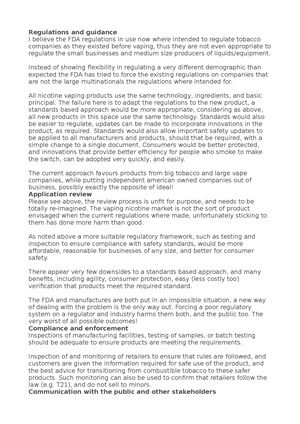
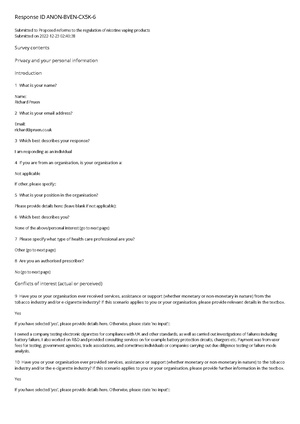
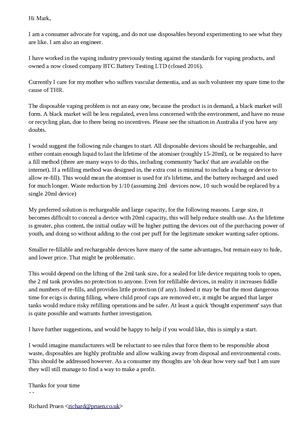

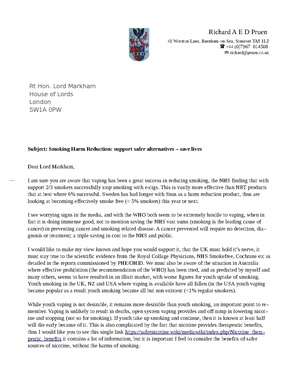

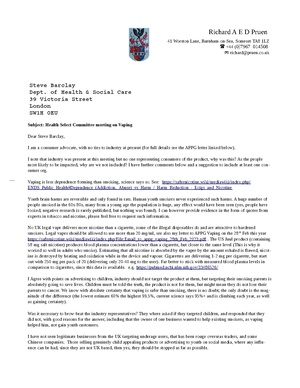
![Response ID ANON-EJTE-W3QH-B Submitted to Proposed reforms to the regulation of vapes Submitted on 2023-09-08 21:15:44 Survey contents Privacy and your personal information I consent to the TGA collecting the information requested in this survey about me, including any sensitive information, for the purposes indicated above. Agree: Yes Acknowledgement I agree. Yes.: Yes Introduction 1 What is your name? Name: Richard Pruen 2 What is your email address? Email: richard@pruen.co.uk 3 What is your organisation name? Organisation name or N/A: n/a 4 Please choose a stakeholder group that best describes you or your organisation. Others* *If other, please specify:: Consumer 5 Which best describes your response? I am responding as an individual. 6 Are you an authorised prescriber? No (please go to next page Conflicts of interest (actual or perceived) 1 Have you or your organisation ever received services, assistance or support (whether monetary or non-monetary in nature) from the tobacco industry and/or e-cigarette industry? If this scenario applies to you or your organisation, please provide relevant details in the textbox. Yes If you have selected yes, please provide details here. Otherwise, please state 'Not Applicable':: I owned a company testing electronic cigarettes for compliance with UK and other standards, as well as carried out investigations of failures including battery failure. I also worked on R&D and provided consulting services on for example battery protection circuits, chargers etc. Payment was from user fees for testing, government agencies (trading standards), trade associations, and sometimes individuals or companies carrying out due diligence testing or failure mode analysis. Ended 2016 since then I have been a consumer only and have not received any funding from any company (of any sort), government agency, or researchinstitution. 2 Have you or your organisation ever provided services, assistance or support (whether monetary or non-monetary in nature) to the tobacco industry and/or the e-cigarette industry? If this scenario applies to you or your organisation, please provide further information in the textbox. Yes If you have selected 'yes', please provide details here. Otherwise, please state 'Not Applicable': I assisted in writing standards for UK vaping products (PAS 54115 A guide for the importation and sale of electronic cigarettes and directly related products, with product safety testing methods) and proposed an IEEE standard project number P2800. Several sampling machines were supplied to others testing electronic cigarettes, and other custom test equipment, the supplied equipment presumably used to carry out tests on electronic cigarettes as designed. As academic and test houses purchased this equipment it is assumed this was paid for by test fees, or grants to carry out tests on electronic cigarettes, again possibly linked to taxes etc from tobacco and or electronic cigarette sales. The same funding source as government agencies, politicians and others working in the field. Again since 2016 I have been a consumer only. Proposal 1 -Restrictions on importation, manufacture and supply of all vapes . 1 Do you support the proposed approach to ban disposable single use vapes absolutely and all other vapes, except those for legitimate therapeutic use in compliance with the TG Act? No 2 How would you anticipate industry and consumers to respond to a ban on the importation, manufacture and supply of non-therapeutic vapes? * Please provide answer here. : Demand will remain, along with the risk of vaping being seen as cool because it is something disallowed. The tightening of rules is unlikely to be enforceable, so illicit supply will continue to be the primary supply to the population. The population know vaping is safer than smoking, thus it will be very difficult to curb demand. Prohibiting drugs such as cocaine and cannabis fails, vaping prohibition will almost certainly follow the same pattern. 3 Do you support removal of the personal importation scheme exception for vapes? If not, what would be the impact on you? No (* if not, what would be the impact on you?) * What would be the impact on you?: Vaping products that are acceptable and usable are likely to only be available via illicit sales, and criminal gangs. Particularly as research shows flavours to be vital for the prevention of release to smoking. These products will not be tested or regulated in any way, importing allows users who have a prescription to import what they need to stay smoke-free, thus not relapse to smoking and potentially death. Importantly importing from somewhere with a regulated legal market, they can be sure of the quality and contents of the products they buy. The one-size-fits-all approved vapes that consumers will find at pharmacy outlets is unlikely to be effective since most of the features that make an effective substitute for cigarettes will be regulated out. 4 Do you agree with the proposal to retain a traveller’s exemption, including the proposed limits? Yes 5 Do you support the proposed approach to prohibiting the advertisement of all vapes (subject to limited exceptions)? No 6 [If applicable] Suppliers, what part of supply chain do you occupy? Not applicable * Other -specify your role in supply chain.: Consumer 6 (a) What proportion of your sales volumes is attributable to vape sales [i.e. quantity of vapes sold]? Please provide details here: (or mark Not applicable).: N/A6 (b) What proportion of your sales revenue is attributable to vape sales [i.e. revenue earned from sales]? Please provide details here: (or mark Not applicable).: N/A 6 (c) What impact would the proposed measures have on your sales volumes? Please provide details here: (or mark Not applicable).: not a vendor, none 6 (d) What impact would the proposed measures have on your sales revenues? Please provide details here: (or mark Not applicable).: none not a vendor 6 (e) What proportion of your vapes sales is attributable to disposable single use vapes versus refillable products? Please provide details here: (or mark Not applicable).: not a vendor 6 (f) How would restricting the importation, manufacture and supply of disposable single use, and non-therapeutic, vapes in Australia impact you? Please provide details here: (or mark Not applicable).: not a vendor N/A 6 (g) How much stock do you have in Australia currently and how long would it take to sell that stock? Please provide details here: (or mark Not applicable).: not a vendor N/A 6 (h) What would be the cost to you if you were required to dispose or otherwise move on existing stock? Please provide details here: (or mark Not applicable).: N/A Proposal 2 -Changes to market accessibility requirements, including better regulation of device components. 7 Do you support the approach to require a pre-market notification of compliance with TGO 110? No 8 [If applicable] For suppliers of therapeutic vapes, what impact would the proposed notification system have on your supply model and what transition period would you require to comply with the new notification requirement? Please provide details here: (or mark Not applicable).: not a vendor 9 Do you support the proposed access to vapes under the SAS C notification system? No 9 (a) What impact would this pathway have on facilitating patient access to therapeutic vapes? Please provide details here: (or mark Not applicable).: Vaping works in the rest of the world as a product substitute, providing a safer alternative to a deadly (cigarettes) product. In the UK and NZ smoking decline has accelerated significantly past that in Australia, due to the adoption of consumer vaping, slightly less so in the US where the regulator is not so certain. The prescription model in Australia has failed, smoking has not continued to decline and may have increased possibly. Vaping is also higher in Australian youth than UK and NZ, the current policy has backfired and should be reversed. It is absolutely obvious at this point that unless you have unlimited resources for enforcement, the current policy is not workable, and never will be. The time has come to use what has worked elsewhere and start again.10 [If applicable] For prescribers, would the proposed new pathway likely change your approach to prescribing therapeutic vapes? How? Not a prescriber of vapes * How new pathway will change your approach to prescribing ttherapeutic vapes?: 11 [If applicable] For prescribers, which access pathway (SAS B, SAS C, or AP) would you envisage using to prescribe therapeutic vapes? Why? Not a prescriber of vapes Please tell us why: 12 [If applicable] For prescribers, would integration of SAS or AP applications or notifications into existing clinical software systems ease the administrative burden and/or encourage you to use the new pathway? Not a prescriber of vapes 13 Do you agree with the proposal to regulate both e-liquid and device components of unapproved vapes under the same part of the TG Act for simplicity? No 14 Will these changes have direct or indirect impact on you? Please provide details. Yes (please provide details below) Please provide details here:: As a consumer I want safer options to be available to me and to every person who smokes tobacco or would smoke tobacco for lack of a viable alternative. Sadly some kids will do adult things even if you try to stop them (for example drinking alcohol, unsafe sex, taking drugs, smoking) while they should not be encouraged to vape, it still offers a harm reduction if it diverts them from smoking, like it or not, this is true because safer is safer. 15 Do you require time to adjust to these requirements? If yes, how long? Yes 15 (a) How long do you require to adjust to these requirements? More than 12 months Proposal 3 - Improving quality standard for unapproved (unregistered) vapes) 16 Are the definitions of nicotine and mint flavours appropriate? If not, please provide reasons. No (* please provide reason below) * Please provide reason here.: Nicotine itself does not have a flavour, the flavour should be correctly referred to as "artificial tobacco flavour" There is no evidence that human flavour preference varies by age and none particularly that it changes at 18. It is therefore impossible to target age groups with specific flavours, thus limiting flavours on this basis has no merit whatsoever. 17 Do you agree with the proposed upper limit on the concentration of menthol in vapes? If not, please provide reasons. No (* please provide reason below) * Please provide reason here: It is trivial to add menthol to vapes, this simply encourages users to add more if they prefer, opening a can of worms and the potential for contamination or incompatible ingredients. This seem unwise for very little if any benefit. 18 [If applicable] Importers, manufacturers and suppliers, would the restrictions on flavour proposed above impact you? Not applicable 19 Do you agree with the proposal to require pharmaceutical-like packaging and presentation for vapes, e.g., vapes manufactured in black, white or grey coloured materials, predominantly white background on packaging, clear warning statements and other restrictions on labels in addition to other selective TGO 91 requirements for vapes? No (* please provide reason below)20 [If applicable] What impact will the labelling and packaging changes have on you? * Please provide detail here.: It will probably backfire, making legal products undesirable is likely to increase the number of people using illicit products, particularly if access remains easy, without enforcement that is most likely to be the case. 20 (a) How long would you need to transition your product to comply with the proposed requirements? More than 12 months 21 Do you agree with our approach to allow only permitted ingredients in vapes, instead of trying to prohibit individual chemical entities from use in e-liquids? No 22 [If applicable] Importers, manufacturers and suppliers, will your therapeutic vapes need any re-formulation or other changes to comply with the permitted ingredients and ingredient quality requirements? Not applicable 22 (a) If product re-formulation is required, how long will you need to make these changes? More than 12 months 22 (b) If product re-formulation is required, what financial or business impacts would be associated with them? Provide detail here or put 'Not Applicable': Not a vendor 23 Do you support applying the same regulatory controls to zero-nicotine therapeutic vapes, as for NVPs? No 24 What is the overall business cost on you to comply with a strengthened TGO 110? Please provide details here: (or mark Not applicable).: not a vendor 25 Do you agree with the proposed requirements under TGO 110 that will apply to unapproved device components of vapes? No 26 [If applicable] Suppliers, do you intend to register any vaping device on the register as an approved medical device? No (if no, why not?) If no, why not?: not a vendor 27 [If applicable] Importers, manufacturers and suppliers, are you familiar with relevant US FDA, or MHRA guidance and/or EU standards covering vaping devices? Not applicable 27 (a) Do your vapes currently comply with relevant US FDA, or MHRA guidance and/or EU standards covering vaping devices? Not applicable 27 (b) If not, what requirements do you meet? What requirements you currently comply with?: not a vendor 27 (c) How long would it take to achieve compliance with relevant standards? More than 12 months28 [If applicable] Importers, manufacturers and suppliers, are your vapes manufactured at facilities that hold relevant international standards for Quality Management Systems, such as ISO9001 or ISO 13485? Not applicable Proposal 4 - Strengthening domestic compliance and enforcement mechanisms 29 Do you have any other comments in relation to this proposal? Yes (* provide your comments below) Comments: I reiterate that Australian policy has failed, and further moves in the same direction are likely to fail. Other countries have shown much more desirable results, the best results on smoking have been where vaping has been accepted as a consumer alternative to smoking, but the prescription model, unfortunately, has proven unworkable. Realistically you should review the past responses to enquiries, select a number of people who have successfully predicted the results of current regulations, and ask them for solutions. At least they have a track record, and proven knowledge of the real world and likely outcomes. Supplementary questions 30 [If applicable] Suppliers, please confirm if you intend to continue to supply therapeutic vapes under the proposed reforms described? Not applicable * Product range : Not a vendor, but as a consumer, I can see vendors dropping out. This will benefit the criminals and gangs who supply illicit markets, more trade for them. 30 (a) How long would it take to meet the new requirements? More than 12 months 31 [If applicable] Suppliers, please confirm if you intend to register your therapeutic vapes in the next 2 years? Not applicable What guidance and/or clarity of supporting data requirements do you need from TGA: not a vendor Publication of submissions To proceed, please select from the options below how you would like the TGA to deal with your submissions: I agree to the TGA publishing my response in full. I request the TGA to consider redacting sensitive commercial information from my response before publication: No Please specify sensitive commercial inforation you want redatced :](/mediawiki/images/thumb/8/8b/TGA_consult_8-sept-2023_my_response.pdf/page1-300px-TGA_consult_8-sept-2023_my_response.pdf.jpg)
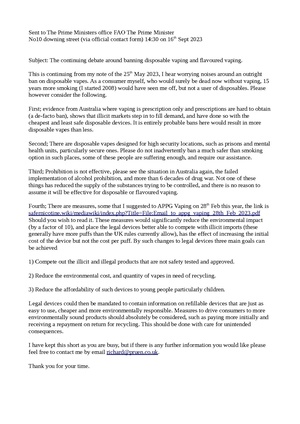


![Subject: COP 10 WHO FCTC Dear Rosanna O’Connor, I am a consumer advocate for vaping, and do not use disposables beyond experimenting to see what they are like. I am also an engineer. I have worked in the vaping industry previously testing compliance with the standards for vaping products, and owned a now closed company BTC Battery Testing LTD (closed 2016). Currently I care for my mother who suffers vascular dementia, and as such volunteer my spare time to the cause of Tobacco Harm Reduction. I believe that consumers should be present at the COP 10 meeting, it is consumers who have the most to gain from stopping the use of combustible tobacco, and the lived experience of trying to do so. Many millions have found a way to eliminate almost all the risk via THR products. The phrase ‘Nothing about us without us’ springs to mind. Why then are the public and press excluded. I would like to see the proceedings live streamed, so those effected can see what is being done. In no way could this effect the discussions, thus is reasonable transparency. I would like an answer regarding the possibility, please. Many countries already found harm reduction useful, critical even. Be that low risk Snus (Sweden has the lowest cancer rate in Europe, and will be smoking free this year (>5%)). Vaping that the UK NHS finds almost 66% effective with support, as stated on their website. New Zealand has seen similar results, especially in native populations, reducing disparities. Japan has seen huge drops in cigarette sales due to reduced harm heated tobacco products. Please see the letter from the Lancet from Robert Beaglehole and Ruth Bonita. They were both senior officials at WHO and are now at the University of Auckland. Robert was formerly Director of the Department of Chronic Disease and Health Promotion at WHO. Ruth was formerly the Director of Surveillance in the Noncommunicable Disease Cluster at WHO. I wish to add my support for their recommendations, the article is attached (also link here https://doi.org/10.1016/S0140-6736(24)00140-5) please make sure these points are discussed at the COP 10 meeting. Yours sincerely, Richard Pruen P.S Please ensure the representatives listed on the next page can discuss before the metting and forward more widely if you agree with the sentiment. Katherine Sands Tobacco Control Team Leader Department for Health and Social Care Martin Dockrell Tobacco Control Programme Lead Department for Health and Social Care Alison Walker Senior Tobacco Control Policy Lead Department of Health and Social Care Esther Lawrence Deputy Head of Global Health UK Mission to the UN, Geneva Please find attached a letter from [THELANCET-D-24-00371] S0140-6736(24)00140-5](/mediawiki/images/thumb/4/4f/Letter_to_cop_10_repersentitives.pdf/page1-300px-Letter_to_cop_10_repersentitives.pdf.jpg)

